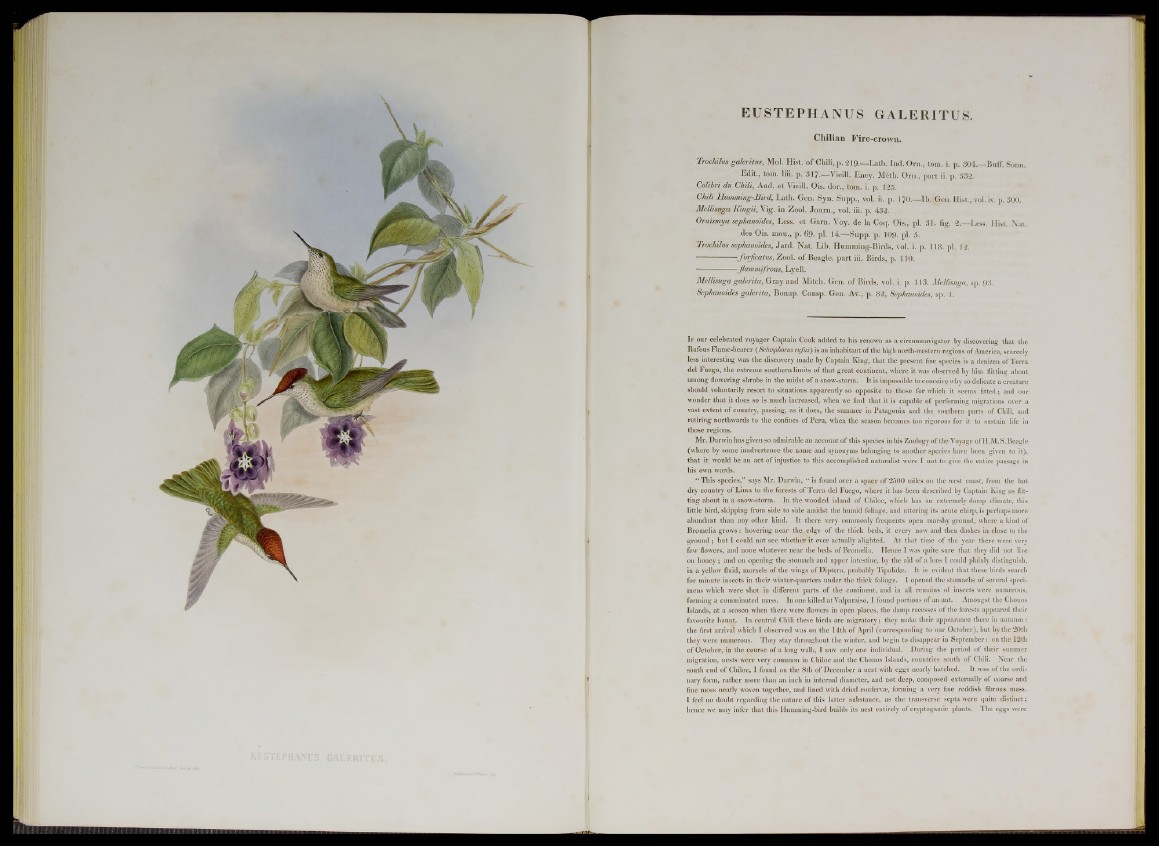
EUST E PHANUS GALERITUS.
Chilian Cire-crown.
Trochilus galeritus, Mol. Hist, o f Chili, p. 219.—Lath. Ind. Orn., tom. i. p. 304.—Buff. Sonn.
E d it., tom. liii. p. 3X7.—Vieill. Ency. M61I1. Orn., p a rt ii. p. 532.
Colibri du Chili, Aud. e t Vieill. Ois. dor., tom. i. p. 125.
Chili Humming-Bird, Lath. Gen. Syn. S upp., vol. ii. p. 170.— Ib . Gen. Hist., vol. iv. p. 300.
Mellisuga LGngu, \ ig. in Zool. Jo u rn ., vol. iii. p. 432.
Ornismya sepliandides, Less, e t Garn. Voy. de la Coq. Ois., pi. 31. fig. 2.— Less. H is t Nat.
des Ois. mou., p. 69. pi. 14.— Supp. p. 109. pi. 5.
Trochilus sepliandides, J a rd . N a t. Lib. Humming-Birds, vol. i. p. 118. pi. 12.
-----------------fo r fic a tm , Zool. o f Beagle, p a rt iii. Birds, p. 110.
-----------------JZammifrons, Lyell.
Mellisuga galerita, Gray and Mitch. Gen. o f B irds, vol. i. p. 113. Mellisuga, sp. 93.
Sephanoides galerita, Bonap. Consp. Gen. Av., p. 82, Sephanoides, sp. 1.
If our celebrated voyager Captain Cook added to his renown as a circumnavigator by discovering that the
Rufous Flame-bearer (Selasphorus rufiis) is an inhabitant of the high north-western regions of America, scarcely
less interesting was the discovery made by Captain King, that the present fine species is a denizen of Terra
del Fuego, the extreme southern limits of that great continent, where it was observed by him flitting about
among flowering shrubs in the midst of a snow-storm. It is impossible to conceive why so delicate a creature
should voluntarily resort to situations apparently so opposite to those for which it seems fitted; and our
wonder that it does so is much increased, when we find that it is capable of performing migrations over a
vast extent of country, passing, as it does, the summer in Patagonia and the southern parts of Chili, and
retiring northwards to the confines of Peru, when the season becomes too rigorous for it to sustain life in
those regions.
Mr. Darwin has given so admirable an account of this species in his Zoology of the Voyage of H. M.S. Beagle
(where by some inadvertence the name and synonyms belonging to another species have been given to it),
that it would be an act of injustice to this accomplished naturalist were I not to give the entire passage in
his own words.
“ This species,” says Mr. Darwin, “ is found over a space of 2500 miles on the west coast, from the hot
dry country of Lima to the forests of Terra del Fuego, where it has been described by Captain King as flitting
about in a snow-storm. In the wooded island of Chiloe, which has an extremely damp climate, this
little bird, skipping from side to side amidst the humid foliage, and uttering its acute chirp, is perhaps more
abundant than any other kind. It there very commonly frequents open marshy ground, where a kind of
Bromelia grows: hovering near the. edge of the thick beds, it every now and then dashes in close to the
ground; but I could not see whether it ever actually alighted. At that time of the year there were very
few flowers, and none whatever near the beds of Bromelia. Hence I was quite sure that they did not live
on honey; and on opening the stomach and upper intestine, by the aid of a lens I could plainly distinguish,
in a yellow fluid, morsels of the wings of Diptera, probably Tipulidae. It is evident that these birds search
for minute insects in their winter-quarters under the thick foliage. I opened the stomachs of several specimens
which were shot in different parts of the continent, and in all remains of insects were numerous,
forming a comminuted mass. In one killed at Valparaiso, I found portions of an ant. Amongst the Chonos
Islands, at a season when there were flowers in open places, the damp recesses of the forests appeared their
favourite haunt. In central Chili these birds are migratory; they make their appearance there in autumn :
the first arrival which I observed was on the 14th of April (corresponding to our October), but by the 20th
they were numerous. They stay throughout the winter, and begin to disappear in September: on the 12th
of October, in the course of a long walk, I saw only one individual. During the period of their summer
migration, nests were very common in Chiloe and the Chonos Islands, countries south of Chili. Near the
south end of Chiloe, I found on the 8th of December a nest with eggs nearly hatched. It was of the ordinary
form, rather more than an inch in internal diameter, and not deep, composed externally of coarse and
fine moss neatly woven together, and lined with dried confervse, forming a very fine reddish fibrous mass.
I feel no doubt regarding the nature of this latter substance, as the transverse septa were quite distinct;
hence we may infer that this Humming-bird builds its nest entirely of cryptogamic plants. The eggs were